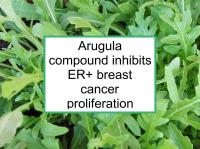Cruciferous vegetables contain a variety of sulfur-containing compounds called glucosinolates which can be converted into various isothiocyanates that have chemopreventive activities against breast cancer. Among the most studied isothiocyanates are sulforaphane, benzyl isothiocyanate, allyl isothiocyanate, and phenethyl isothiocyanate (PEITC).
For example, PEITC (whose richest source is watercress) has been shown to inhibit tumor cell angiogenesis (the growth of new blood vessels). Now a new study has reported that erucin, the major isothiocyanate in arugula, inhibits the growth of hormone receptor positive (ER+/PR+) breast cancer cells.
Cruciferous vegetable intake is associated with reduced BC risk
A number of population studies have found a lower risk of breast cancer associated with consumption of one or more cruciferous vegetables. Urinary isothiocyanate levels have been found to be related to lower breast cancer risk among both premenopausal and postmenopausal women. One prospective study reported that breast cancer patients taking tamoxifen who also had relatively high cruciferous vegetable consumption were less likely to experience a recurrence than tamoxifen users with low intake.
Sources of isothiocyanates
Below are common foods containing meaningful levels of isothiocyanates:It is not advisable to take isothiocyanate supplements. First, it has been demonstrated that chemopreventive levels of these compounds can be obtained by including cruciferous vegetables in the diet. Second, isothiocyanates may damage the DNA of normal cells at doses obtainable through use of broccoli extracts, sulforaphane supplements, and other concentrated sources.
Latest research finds erucin inhibits breast cancer cell proliferation
The study referenced at the beginning of this news article was designed to investigate the cancer preventive actions of erucin (1-isothiocyanato-4-(methylthio)butane). Erucin is an isothiocyanate that is structurally and metabolically and related to sulforaphane. The most abundant sources of erucin are arugula, kohlrabi and Chinese cabbage. Erucin's mechanism of action in preventing cancer has until now been poorly understood.
In the study, the authors found that erucin inhibits proliferation of ER+/PR+ MCF-7 breast cancer cells by means of cell cycle arrest at mitosis and subsequent apoptosis (programmed cell death). The mechanism of action is consistent with impairment of microtubule dynamics. Further analysis demonstrated that erucin suppressed the required dynamic instability of microtubules during interphase (the main portion of the cell cycle during which the cell is not dividing but is preparing for the next cellular division). Most measures of dynamic instability were found to be inhibited by erucin.
In fact, similarly to sulforaphane, the effects of erucin on microtubule dynamics were found to resemble qualitatively the much more powerful microtubule-targeting chemotherapy drugs, including taxanes such as paclitaxel and the vinca alkaloids. The authors conclude that erucin's cancer preventive activities may by the result of suppression of microtubule dynamics and the resulting impairment of vital microtubule-dependent cell functions such as mitosis, cell migration and microtubule-based transport.
Please see our articles on greens and what ER+/PR+ breast cancer patients and survivors should eat for more information.
